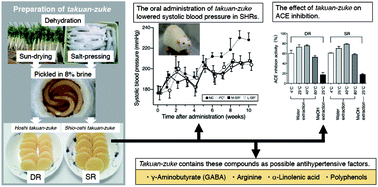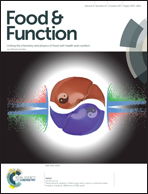The salted radish takuan-zuke shows antihypertension effects in spontaneously hypertensive rats
Abstract
Recently, we reported that the antihypertensive compound, γ-aminobutyrate (GABA), increases over time during the dehydration of salted radish, known as takuan-zuke, a popular pickle in Japan. The objective of this study was to clarify the antihypertensive effects of takuan-zuke. We prepared two types of takuan-zuke by sun-drying (hoshi takuan-zuke) and salt-pressing (shio-oshi takuan-zuke) using dehydration processes. The oral administration of takuan-zuke lowered systolic blood pressure in spontaneously hypertensive rats (SHRs). Shio-oshi takuan-zuke (SR) demonstrated a clear antihypertension effect compared with hoshi takuan-zuke (DR), despite equal GABA concentrations in the feed. Furthermore, takuan-zuke demonstrated angiotensin converting enzyme (ACE) inhibition in vitro. These findings indicated that takuan-zuke contains unknown substances that have hypotensive actions independent of GABA. Further evaluation revealed that takuan-zuke contains polyphenols, arginine, and α-linolenic acid as possible antihypertensive factors. Collectively, our results suggest that the salty Japanese food takuan-zuke has antihypertensive effects in vivo, likely involving complex mechanisms.



 Please wait while we load your content...
Please wait while we load your content...